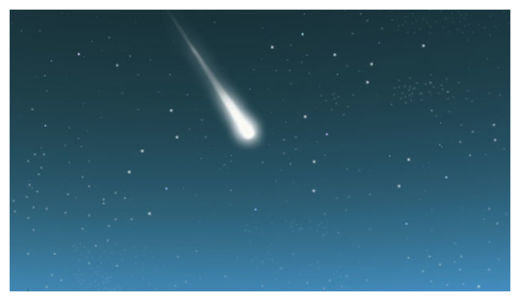
© iStockphoto
There have been reports that a bright green object was seen in the sky from Conception bay South, eastern Newfoundland. This image wasn't taken recently it is for story illustration purposes only.
There have been reports that a bright green object was seen in the sky from Conception bay South, eastern Newfoundland. This image wasn't taken recently it is for story illustration purposes only.
Facebook and Twitter social media sites on the northeast Avalon were busy with reports of an unidentified, green object falling in the sky over Conception Bay South Wednesday night.
"It was turquoise in colour and was rounded on the bottom and tapered to a point on top. It looked big, but it was hard to tell how far away it was. It was moving extremely fast toward the ground," said a Facebook status update from the St. John's area.
"I've read about a couple of natural phenomena now that could explain it ... something called a green fireball and a meteor - which can apparently be blue, white or green," said another one.
No one has reported an alien abduction yet ... but the reports on Twitter and Facebook weren't isolated to eastern Newfoundland.
People from many parts of the northeastern U.S. also posted reports on astronomy internet forums all evening claiming they saw a green light in the sky.
"Almost certainly it was what we call a bolide, which is a very bright, sporadic meteor much brighter than the run of the mill meteor. These things can rival the brightness of the full moon," said Chris Stevenson of the Royal Astronomical Society of Newfoundland and Labrador.
"One tip off - despite the fact that green is our favourite alien colour - is that this was reported as blue/green."
Stevenson said most meteors are basically large rocks the size of a baseball or maybe as large as a basketball. He said when they hit the Earth's atmosphere at several tens of kilometres per second they burn up very fiercely and very brightly.
He said the sightings Wednesday appear to be concentrated in the northeast U.S., Quebec and Ontario and Newfoundland.
"It's not an airplane, they move more slowing," said Stevenson.
He also ruled out extraterrestrials.
"Definitely not aliens unless they are hardy little buggers that can survive very ferocious temperatures," said Stevenson.

© Rich Beauchesne/rbeauchesne@seacoastonline.com
Aidan Ulery of Exeter holds several pieces of what are believed to be stony meteorites. He said that, after seeing a giant, green fireball in the sky at about 10:15 Tuesday night, he went in search of an impact site.
Aidan Ulery of Exeter holds several pieces of what are believed to be stony meteorites. He said that, after seeing a giant, green fireball in the sky at about 10:15 Tuesday night, he went in search of an impact site.
A piece of a meteoric fireball that was seen across the region may have landed on one of the town's streets.
The fireball, caused when debris burns up in the atmosphere, was spotted by numerous people in New England and Canada on Tuesday night, including Aidan Ulery, 32, of Exeter.
Ulery was at a friend's home on Main Street between 10 and 10:30 p.m., when he saw the light.
"I thought it was a spaceship at first, honestly," Ulery said. "It was a 10-foot, green ball that came suddenly down from the sky."
But unlike the others who reported sightings across the region, Ulery swore the object struck nearby on Park Street, and went looking for it. While he didn't find anything Tuesday night, Ulery said he knew something was different.
"I could smell it," he said.
He returned to Park Street on Wednesday morning and found a small dent in the middle of the road and chunks of what he believes was a meteorite.
Ulery then brought the chunks to Santerre's Stones 'n Stuff on Water Street, where the store's owner, rock lover Neil Santerre, was impressed by the discovery.
Santerre said meteors typically contain iron, nickle and stone, or some combination of those materials.
"This one kind of falls into the stone category," Santerre said of Ulery's discovery.
Santerre said, in addition to containing stone, the chunks were also magnetic.
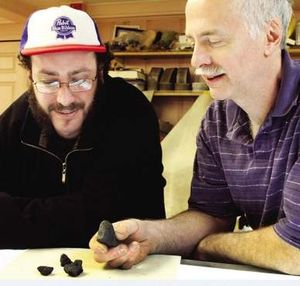
© Rich Beauchesne/rbeauchesne@seacoastonline.com
Aidan Ulery of Exeter, left, meets with Neil Santerre, an expert rock collector and owner of Santerre's Stones 'n Stuff in Exeter, to examine what they believe are meteor fragments that landed in Exeter.
Aidan Ulery of Exeter, left, meets with Neil Santerre, an expert rock collector and owner of Santerre's Stones 'n Stuff in Exeter, to examine what they believe are meteor fragments that landed in Exeter.
Santerre said it's possible other pieces of the suspected meteorite fell elsewhere, but they may never be found, because they'll eventually just blend in.
"This is really rare," Santerre said. "I never thought I would see a fresh one."
Tiffany Nardino, education director at the McAuliffe-Shepard Discovery Center in Concord, said sightings of Tuesday night's fireball were reported all over, including to many area police departments.
She said people continue to report the sightings to the American Meteor Society. Some people reported seeing a red fireball, others reported that it was green, blue or white, according to Nardino.
"All of them said it was extremely bright, and a few of them claimed to see it explode," she said. "Fireballs are rare; to see one explode is even more rare."
Nardino said, in many cases, meteors are vaporized in the atmosphere, but if it exploded close to the ground, it's possible that some pieces, called meteorites, could've made it to the ground.
She said the pieces would have a black outer coating and would be magnetic, like the chunks Ulery discovered.
Nardino said the best way to confirm Ulery's discovery would be to perform chemical analyses on the chunks of material.
Ulery, who works at the popular downtown eatery The Loaf & Ladle, said he would like to get the chunks checked by a geologist to confirm they're meteorites, and then sell them.
He added that it's fitting that he found the chunks because, three days ago, he got a fortune from a fortune cookie that stated something major would happen to him in three days.
"This is weird," he said, laughing.
Santerre said it would be ironic if the chunks were confirmed to be meteorites that landed in Exeter, given Exeter's UFO history, which includes an incident in 1965 that is considered one of the most well-documented UFO sightings in the United States.
"Obviously, it's just the luck of the draw; the meteor doesn't care where it lands," he said. "Who knows?"
Similar reports were made throughout the northeastern U.S. Wednesday
A video of the meteor taken at 22:12 EST on 28 February 2012 in Dunrobin, Ontario, Canada:
Facebook and Twitter social media sites on the northeast Avalon were busy with reports of an unidentified, green object falling in the sky over Conception Bay South Wednesday night.
"It was turquoise in colour and was rounded on the bottom and tapered to a point on top. It looked big, but it was hard to tell how far away it was. It was moving extremely fast toward the ground," said a Facebook status update from the St. John's area.
"I've read about a couple of natural phenomena now that could explain it ... something called a green fireball and a meteor - which can apparently be blue, white or green," said another one.
No one has reported an alien abduction yet ... but the reports on Twitter and Facebook weren't isolated to eastern Newfoundland.
People from many parts of the northeastern U.S. also posted reports on astronomy internet forums all evening claiming they saw a green light in the sky.
"Almost certainly it was what we call a bolide, which is a very bright, sporadic meteor much brighter than the run of the mill meteor. These things can rival the brightness of the full moon," said Chris Stevenson the St. John's Centre of the Royal Astronomical Society of Canada.
"One tip off - despite the fact that green is our favourite alien colour - is that this was reported as blue/green."
Stevenson said most meteors are basically large rocks the size of a baseball or maybe as large as a basketball. He said when they hit the Earth's atmosphere at several tens of kilometres per second they burn up very fiercely and very brightly.
He said the sightings Wednesday appear to be concentrated in the northeast U.S., Quebec and Ontario and Newfoundland.
"It's not an airplane, they move more slowing," said Stevenson.
He also ruled out extraterrestrials.
"Definitely not aliens unless they are hardy little buggers that can survive very ferocious temperatures," said Stevenson.
A video of the meteor taken at 22:12 EST on 28 February 2012 in Dunrobin, Ontario, Canada:
Facebook and Twitter social media sites on the northeast Avalon were busy with reports of an unidentified, green object falling in the sky over Conception Bay South Wednesday night.
"It was turquoise in colour and was rounded on the bottom and tapered to a point on top. It looked big, but it was hard to tell how far away it was. It was moving extremely fast toward the ground," said a Facebook status update from the St. John's area.
"I've read about a couple of natural phenomena now that could explain it ... something called a green fireball and a meteor - which can apparently be blue, white or green," said another one.
No one has reported an alien abduction yet ... but the reports on Twitter and Facebook weren't isolated to eastern Newfoundland.
People from many parts of the northeastern U.S. also posted reports on astronomy internet forums all evening claiming they saw a green light in the sky.
"Almost certainly it was what we call a bolide, which is a very bright, sporadic meteor much brighter than the run of the mill meteor. These things can rival the brightness of the full moon," said Chris Stevenson the St. John's Centre of the Royal Astronomical Society of Canada.
"One tip off - despite the fact that green is our favourite alien colour - is that this was reported as blue/green."
Stevenson said most meteors are basically large rocks the size of a baseball or maybe as large as a basketball. He said when they hit the Earth's atmosphere at several tens of kilometres per second they burn up very fiercely and very brightly.
He said the sightings Wednesday appear to be concentrated in the northeast U.S., Quebec and Ontario and Newfoundland.
"It's not an airplane, they move more slowing," said Stevenson.
He also ruled out extraterrestrials.
"Definitely not aliens unless they are hardy little buggers that can survive very ferocious temperatures," said Stevenson.
How Likely Am I To Be Hit By an Asteroid?
A report suggests that there should be 91 deaths every year from asteroid strikes, but what are the chances of that actually happening?
Buy insurance. Tick. Health check. Tick. Drive sensibly. Tick. As a general rule, we humans like to control our lives. But let's face it, all of this caution is a complete waste of time if a huge rock from space has your name on it.
Take the recent 'near-miss' by the poetically-named asteroid 2012 BX34, which was only discovered two days before it sailed past within 40,000 miles (60,000km) of Earth. What if it had been heading straight for us?
A wonderful report from the US National Research Council (NRC) says that on average there should be 91 deaths per year from asteroid strikes - a remarkably precise figure and one that deserves some digging.
Try to think of when you last heard about an asteroid striking the earth. There really aren't that many of them, or at least that many that are noticed or reported in newspapers.
One of the last significant impacts occurred on 30 June 1908, when an asteroid or comet exploded 6.2 miles (10km) above a secluded forest in Tunguska, Siberia, flattening trees over an area of 625 sq miles (1600 sq km), which surprisingly few people cared about at the time due to the remoteness of the region and the fact that there seem to have been no casualties.
Calculations suggest that if it had landed 4 hours and 47 minutes later, it would have hit St Petersburg1, in which case people might have cared a lot, particularly as it was rather a delicate time in Russian history. According to estimates, such an airburst occurring over New York would cost $1.19tn to insurers in property damage, not to mention causing approximately 3.2 million fatalities and 3.76 million injuries.
But that has not occurred. In fact, there are surprisingly few reports of fatalities involving asteroids. A few cars in the United States have been damaged and there was a case of a cow being killed in Valera, Venezuela in 1972 - the unfortunate animal was duly eaten and bits of the meteorite were later sold to collectors. A home outside Paris was also recently hit by an egg-shaped meteorite, but the appropriately-named Comette family were away at the time.
So how can the NRC be so precise? Well, to understand we need to understand how astronomers and statisticians think about these risks.
As these threats come in all shapes and sizes astronomers have established a classification system to help gauge the potential level of risk. If asteroids or comets come within one-third of the distance from the Earth to the Sun - just over 30 million miles (48 million km) - they are labelled as Near Earth Objects (NEOs). 'Near' is clearly a relative term, though this does show how comparatively close asteroid 2012 BX34 came. Fortunately, there are observatories watching over us and Nasa's Near Object Program is keeping count of what is passing through our local area. By December 2011, over 8,500 NEOs had been found and named, with around 500 being added to the list every year.
If an object is found that is at least 480ft (150m) across, and which will pass closer than 20 times the distance between the moon and the Earth (around five million miles, or eight million km), it earns itself the status of Potentially Hazardous Asteroid (PHA). If anything this big were to hit the Earth, the consequences would be serious. So far 1,271 of these have been found, of which 151 are of more than 0.6 miles (1km) in diameter, a size that could be globally catastrophic.
Working out the chances of an Earth-asteroid collision and the damage it would cause is not like an insurer dealing with a collision between two cars: there is almost no direct historical data, so astronomers create equations relating to the size of an asteroid, how many there are around, how often they might hit the Earth and what the explosive force of any impact would be. These estimates are continually being revised and are subject to some esoteric disputes.
Asteroids in the 16-32 feet (5-10m) diameter range find their way to Earth around once per year, releasing energy equivalent to approximately 15,000 tons of TNT when they explode: about the same as the bomb detonated over Hiroshima. Most go unseen and unrecorded. An airburst of an 80ft (25m) asteroid would release energy equivalent to around one million tons of TNT, or one megaton (Mt), equivalent to around 65 Hiroshima bombs. That same NRC report estimates an average of 200 years between such impacts.
The Tunguska devastation in Siberia is thought to have been caused by an asteroid of around 160ft (50m) diameter exploding 6 miles (10km) up, releasing 10Mt of energy. The NRC estimates an average interval of 2,000 years between events of this size, although other studies have suggested that Tunguska-like events could be caused by objects as small as 100ft (30m), which would equate to nearly a 50:50 chance of such an event occurring in a given lifetime2.
Bigger asteroids start being considered as 'continental-scale events', although it is tricky to predict what damage such a major impact would cause. Due to the differing coverage of the Earth's surface, there is a 70% chance that any such impact would hit the ocean, and models have suggested a 1,300ft (400m) asteroid could cause a tsunami 650ft (200m) high3, although with regards to possible consequences, there is great uncertainty about whether such a wave would break on the continental shelf, whether the population could evacuate, and so on.
Mass extinctions
Nasa estimate that there are currently around 900 Near Earth Objects of over 0.6 miles (1km) across, and if one hit us it would release around 100,000Mt of energy. Such an impact would almost certainly be globally catastrophic. Thankfully, such strikes should only be expected every 700,000 years, but even bigger collisions have occurred. Considerably more than just one cow perished when a 6 mile (10km) wide, 100,000,000Mt lump hit the Yucatan peninsula in modern-day Mexico 65 million years ago: this impact is credited with changing the climate and wiping out the dinosaurs. But such mass extinction events are only estimated to come along every 100 million years or so. So not much need to worry there, then.
In terms of future threats, the current catalogue indicates no serious risk from asteroids that we know of. The biggest known danger Nasa can point to is a 1 in 600 chance of a collision with the 460ft (140m) 2011-AG5 asteroid sometime in the 2040s. But most asteroids less than 1,640ft (500m) across remain undiscovered, and although these would be unlikely to cause a global catastrophe, they could certainly take us by surprise. 2008 TC3 was 6-16ft (2-5m) across and weighed around 80 tons when it exploded over the Sudanese desert on 7 October 2008. It was the first asteroid to ever be detected before impact, but it was only picked up 19 hours prior to its destruction, and one can imagine the crisis if its predicted path had passed over a big city. It exploded with a force of around 2,000 tons of TNT and 10kg of fragments were picked up afterwards - though thankfully nobody was hurt.
Is it worth getting up?
So, once again, back to that figure of 91 deaths.
This now begins to make more sense when you realise that it is an average taken over millennia, in which almost all years show no deaths, but a few isolated events cause massive casualties. In fact, the figure of 91 deaths is almost evenly balanced between more frequent, smaller-scale impacts, and statistically very infrequent globally catastrophic impacts.
So, I know what you are now thinking: what is the risk of being killed by an asteroid in my bed - or anywhere else for that matter - in my lifetime?
As I said in my first column, statisticians like to define such risk events in terms of micromorts: that is, a one-in-a-million chance of dying. Since there are 7 billion people on Earth and 91 people are expected to die every year from an asteroid impact, this works out at 1/77 micromorts per person per year - about the same risk as a 3 mile (5 km) car journey, but much less risky than riding a motorcycle for 60 miles (97km) in the UK (around 10 micromorts).
Assuming a lifetime of around 77 years, this comes to the delightfully round number of one micromort per lifetime from asteroids. Which, as risks go, is hardly the end of the world.
References
1. Woo G. Calculating Catastrophe. 1st ed. Imperial College Press; 2011. 368 p.
2. Boslough MBE, Crawford DA. Low-altitude airbursts and the impact threat. International Journal of Impact Engineering. (2008) 35: 1441 - 1448.
3. Ward SN, Asphaug E. Asteroid Impact Tsunami: A Probabilistic Hazard Assessment. Icarus. (2000) 145:64 - 78.
Buy insurance. Tick. Health check. Tick. Drive sensibly. Tick. As a general rule, we humans like to control our lives. But let's face it, all of this caution is a complete waste of time if a huge rock from space has your name on it.
Take the recent 'near-miss' by the poetically-named asteroid 2012 BX34, which was only discovered two days before it sailed past within 40,000 miles (60,000km) of Earth. What if it had been heading straight for us?
A wonderful report from the US National Research Council (NRC) says that on average there should be 91 deaths per year from asteroid strikes - a remarkably precise figure and one that deserves some digging.
Try to think of when you last heard about an asteroid striking the earth. There really aren't that many of them, or at least that many that are noticed or reported in newspapers.
One of the last significant impacts occurred on 30 June 1908, when an asteroid or comet exploded 6.2 miles (10km) above a secluded forest in Tunguska, Siberia, flattening trees over an area of 625 sq miles (1600 sq km), which surprisingly few people cared about at the time due to the remoteness of the region and the fact that there seem to have been no casualties.
Calculations suggest that if it had landed 4 hours and 47 minutes later, it would have hit St Petersburg1, in which case people might have cared a lot, particularly as it was rather a delicate time in Russian history. According to estimates, such an airburst occurring over New York would cost $1.19tn to insurers in property damage, not to mention causing approximately 3.2 million fatalities and 3.76 million injuries.
But that has not occurred. In fact, there are surprisingly few reports of fatalities involving asteroids. A few cars in the United States have been damaged and there was a case of a cow being killed in Valera, Venezuela in 1972 - the unfortunate animal was duly eaten and bits of the meteorite were later sold to collectors. A home outside Paris was also recently hit by an egg-shaped meteorite, but the appropriately-named Comette family were away at the time.
So how can the NRC be so precise? Well, to understand we need to understand how astronomers and statisticians think about these risks.
As these threats come in all shapes and sizes astronomers have established a classification system to help gauge the potential level of risk. If asteroids or comets come within one-third of the distance from the Earth to the Sun - just over 30 million miles (48 million km) - they are labelled as Near Earth Objects (NEOs). 'Near' is clearly a relative term, though this does show how comparatively close asteroid 2012 BX34 came. Fortunately, there are observatories watching over us and Nasa's Near Object Program is keeping count of what is passing through our local area. By December 2011, over 8,500 NEOs had been found and named, with around 500 being added to the list every year.
If an object is found that is at least 480ft (150m) across, and which will pass closer than 20 times the distance between the moon and the Earth (around five million miles, or eight million km), it earns itself the status of Potentially Hazardous Asteroid (PHA). If anything this big were to hit the Earth, the consequences would be serious. So far 1,271 of these have been found, of which 151 are of more than 0.6 miles (1km) in diameter, a size that could be globally catastrophic.
Working out the chances of an Earth-asteroid collision and the damage it would cause is not like an insurer dealing with a collision between two cars: there is almost no direct historical data, so astronomers create equations relating to the size of an asteroid, how many there are around, how often they might hit the Earth and what the explosive force of any impact would be. These estimates are continually being revised and are subject to some esoteric disputes.
Asteroids in the 16-32 feet (5-10m) diameter range find their way to Earth around once per year, releasing energy equivalent to approximately 15,000 tons of TNT when they explode: about the same as the bomb detonated over Hiroshima. Most go unseen and unrecorded. An airburst of an 80ft (25m) asteroid would release energy equivalent to around one million tons of TNT, or one megaton (Mt), equivalent to around 65 Hiroshima bombs. That same NRC report estimates an average of 200 years between such impacts.
The Tunguska devastation in Siberia is thought to have been caused by an asteroid of around 160ft (50m) diameter exploding 6 miles (10km) up, releasing 10Mt of energy. The NRC estimates an average interval of 2,000 years between events of this size, although other studies have suggested that Tunguska-like events could be caused by objects as small as 100ft (30m), which would equate to nearly a 50:50 chance of such an event occurring in a given lifetime2.
Bigger asteroids start being considered as 'continental-scale events', although it is tricky to predict what damage such a major impact would cause. Due to the differing coverage of the Earth's surface, there is a 70% chance that any such impact would hit the ocean, and models have suggested a 1,300ft (400m) asteroid could cause a tsunami 650ft (200m) high3, although with regards to possible consequences, there is great uncertainty about whether such a wave would break on the continental shelf, whether the population could evacuate, and so on.
Mass extinctions
Nasa estimate that there are currently around 900 Near Earth Objects of over 0.6 miles (1km) across, and if one hit us it would release around 100,000Mt of energy. Such an impact would almost certainly be globally catastrophic. Thankfully, such strikes should only be expected every 700,000 years, but even bigger collisions have occurred. Considerably more than just one cow perished when a 6 mile (10km) wide, 100,000,000Mt lump hit the Yucatan peninsula in modern-day Mexico 65 million years ago: this impact is credited with changing the climate and wiping out the dinosaurs. But such mass extinction events are only estimated to come along every 100 million years or so. So not much need to worry there, then.
In terms of future threats, the current catalogue indicates no serious risk from asteroids that we know of. The biggest known danger Nasa can point to is a 1 in 600 chance of a collision with the 460ft (140m) 2011-AG5 asteroid sometime in the 2040s. But most asteroids less than 1,640ft (500m) across remain undiscovered, and although these would be unlikely to cause a global catastrophe, they could certainly take us by surprise. 2008 TC3 was 6-16ft (2-5m) across and weighed around 80 tons when it exploded over the Sudanese desert on 7 October 2008. It was the first asteroid to ever be detected before impact, but it was only picked up 19 hours prior to its destruction, and one can imagine the crisis if its predicted path had passed over a big city. It exploded with a force of around 2,000 tons of TNT and 10kg of fragments were picked up afterwards - though thankfully nobody was hurt.
Is it worth getting up?
So, once again, back to that figure of 91 deaths.
This now begins to make more sense when you realise that it is an average taken over millennia, in which almost all years show no deaths, but a few isolated events cause massive casualties. In fact, the figure of 91 deaths is almost evenly balanced between more frequent, smaller-scale impacts, and statistically very infrequent globally catastrophic impacts.
So, I know what you are now thinking: what is the risk of being killed by an asteroid in my bed - or anywhere else for that matter - in my lifetime?
As I said in my first column, statisticians like to define such risk events in terms of micromorts: that is, a one-in-a-million chance of dying. Since there are 7 billion people on Earth and 91 people are expected to die every year from an asteroid impact, this works out at 1/77 micromorts per person per year - about the same risk as a 3 mile (5 km) car journey, but much less risky than riding a motorcycle for 60 miles (97km) in the UK (around 10 micromorts).
Assuming a lifetime of around 77 years, this comes to the delightfully round number of one micromort per lifetime from asteroids. Which, as risks go, is hardly the end of the world.
References
1. Woo G. Calculating Catastrophe. 1st ed. Imperial College Press; 2011. 368 p.
2. Boslough MBE, Crawford DA. Low-altitude airbursts and the impact threat. International Journal of Impact Engineering. (2008) 35: 1441 - 1448.
3. Ward SN, Asphaug E. Asteroid Impact Tsunami: A Probabilistic Hazard Assessment. Icarus. (2000) 145:64 - 78.
Comment: For more information on impact events, see these exclusive Sott articles:
Impact Hazards on a Populated Earth
Meteorites, Asteroids and Comets: Damages, Disasters, Injuries, Deaths and Very Close Calls
It is thought many people witnessed the event, as it the fireball was extremely bright and it was followed by a loud bang.
Astronomer Knut Jørgen Røed Ødegaard, who is behind website Bangirommet.no, is asking for any information that people can provide about it.
He would also like information on any meteorites that may have fallen to the ground, advising people to look on frozen lakes where smaller rocks will not have had the power to go through the ice.
The rocks are likely to be almost or completely black and will stand out easily on road surfaces.
Mr Røed Ødegaard tells The Foreigner, "I've received 800 answers with reports of sightings so far, from southern Norway and Sweden.
"We are now better able to pinpoint the probably location of where the many fragments, known as meteorites, landed. These were in Norefjell, southwestern Norway."
Norefjell is a mountain range in Buskerud County, with valleys Hallingdal and Eggedal and Numedal.
Watch the video by Steinar Midtskogen here (external link).
Astronomer Knut Jørgen Røed Ødegaard, who is behind website Bangirommet.no, is asking for any information that people can provide about it.
He would also like information on any meteorites that may have fallen to the ground, advising people to look on frozen lakes where smaller rocks will not have had the power to go through the ice.
The rocks are likely to be almost or completely black and will stand out easily on road surfaces.
Mr Røed Ødegaard tells The Foreigner, "I've received 800 answers with reports of sightings so far, from southern Norway and Sweden.
"We are now better able to pinpoint the probably location of where the many fragments, known as meteorites, landed. These were in Norefjell, southwestern Norway."
Norefjell is a mountain range in Buskerud County, with valleys Hallingdal and Eggedal and Numedal.
Watch the video by Steinar Midtskogen here (external link).
Comment: Here is an all-sky camera shot of the fireball:
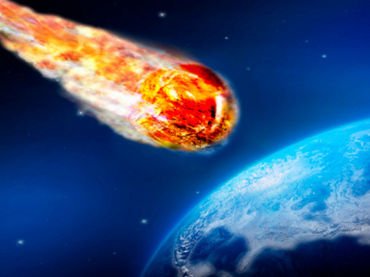
© unknown
A dangerous asteroid heading to the Earth was spotted by stargazers three years after it had got onto its current orbit
A dangerous asteroid heading to the Earth was spotted by stargazers three years after it had got onto its current orbit
NASA confirms the 60-meter (197-feet) asteroid, spotted by Spanish stargazers in February, has a good chance of colliding with Earth in eleven months.
The rock's closest approach to the planet is scheduled for February 15, 2013, when the distance between the planet and space wanderer will be under 27,000 km (16,700 miles). This is lower than the geosynchronous orbit kept by the Google Maps satellite.
Fireworks and watercolors
With the asteroid zooming that low, it will be too late to do anything with it besides trying to predict its final destination and the consequences of impact.
A spaceship is needed, experts agree. It could shoot the rock down or just crash into it, either breaking the asteroid into debris or throwing it off course.
"We could paint it," says NASA expert David Dunham.
Paint would affect the asteroid's ability to reflect sunlight, changing its temperature and altering its spin. The asteroid would stalk off its current course, but this could also make the boulder even more dangerous when it comes back in 2056, Aleksandr Devaytkin, the head of the observatory in Russia's Pulkovo, told Izvestia.
Spaceship impossible?
Whatever the mission, building a spaceship to deal with 2012 DA14 will take two years - at least.
The asteroid has proven a bitter discovery. It has been circling in orbit for three years already, crossing Earth's path several times, says space analyst Sergey Naroenkov from the Russian Academy of Sciences. It seems that spotting danger from outer space is still the area where mere chance reigns, while asteroid defense systems exist only in drafts.
Still, prospects of meeting 2012 DA14 are not all doom and gloom.
"The asteroid may split into pieces entering the atmosphere. In this case, most part of it will never reach the planet's surface," remarks Dunham.
But if the entire asteroid is to crash into the planet, the impact will be as hard as in the Tunguska blast, which in 1908 knocked down trees over a total area of 2,150 sq km (830 sq miles) in Siberia. This is almost the size of Luxembourg. In today's case, the destination of the asteroid is yet to be determined.
Comment: SOTT considers it highly unlikely that this asteroid will impact earth. We have had close misses in the past. 28000km is certainly a relatively short distance, it's about 7% of the Earth-Moon distance, but please remember we had had an even closer miss last year at 4% Lunar distance: Close Shave
For the moment it is not possible to predict exactly how this object will act when it gets close to Earth because of the various gravitational and non-gravitational perturbations. So wait and see as usual.
We should be more worried about those things we don't see...
Thousands of stargazers witnessed a spectacular meteor shower last night.
It lit up the skies across the north of England and was spotted as far south as Peterborough.
The meteor exploded after streaking across the night sky for more than 30 seconds.
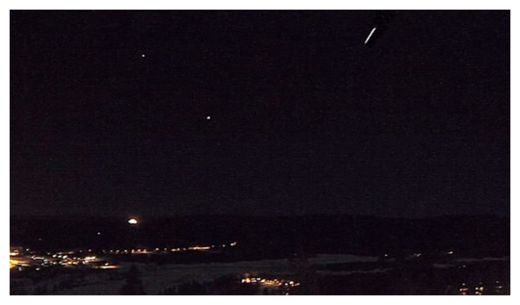
The shower was seen at various locations across England, including Manchester, Derbyshire and the Lake District.
Hundreds of people posted messages on Twitter after witnessing the event unfold. Scores even put their own video footage of the shower on the internet.
The meteor was first spotted at 9.38pm but other sightings were reported until 9.45pm - which backed up speculation on Twitter that there had been more than one meteor.
Some reports suggested there was a large meteor followed by a series of smaller ones.
One Twitter user wrote: 'The Amazing #Meteor looked like a plane from Man Airport but then seems to rise and burn up in front of me near #JodrellBank.'
Meteors - or shooting stars - are the result of small particles entering the Earth's atmosphere at high speed.
They burn up and shine as a short-lived streak of light.
Meteor showers in the UK are fairly common, but it is rare that there is a clear enough night for people to see them across the length of the country.
They are also not normally as large or as close as those spotted last night.
The last meteor shower passed overhead in January.
That show was brief but intense and those who caught it witnessed 60 and 200 meteor streaks an hour.
One of the annual displays - known as the Geminid meteor shower - comes from the remains of an extinct comet.
Some experts believe it is becoming more spectacular. At its peak up to 100 shooting stars may be seen every hour.
It lit up the skies across the north of England and was spotted as far south as Peterborough.
The meteor exploded after streaking across the night sky for more than 30 seconds.

© The Daily Mail, UK
Starstruck: The meteor, visible in the top right hand corner of this image as an elongated white streak, was seen in the skies across the north of England and was spotted as far south as Peterborough.
Starstruck: The meteor, visible in the top right hand corner of this image as an elongated white streak, was seen in the skies across the north of England and was spotted as far south as Peterborough.
Hundreds of people posted messages on Twitter after witnessing the event unfold. Scores even put their own video footage of the shower on the internet.
The meteor was first spotted at 9.38pm but other sightings were reported until 9.45pm - which backed up speculation on Twitter that there had been more than one meteor.
Some reports suggested there was a large meteor followed by a series of smaller ones.
One Twitter user wrote: 'The Amazing #Meteor looked like a plane from Man Airport but then seems to rise and burn up in front of me near #JodrellBank.'
Meteors - or shooting stars - are the result of small particles entering the Earth's atmosphere at high speed.
They burn up and shine as a short-lived streak of light.
Meteor showers in the UK are fairly common, but it is rare that there is a clear enough night for people to see them across the length of the country.
They are also not normally as large or as close as those spotted last night.
The last meteor shower passed overhead in January.
That show was brief but intense and those who caught it witnessed 60 and 200 meteor streaks an hour.
One of the annual displays - known as the Geminid meteor shower - comes from the remains of an extinct comet.
Some experts believe it is becoming more spectacular. At its peak up to 100 shooting stars may be seen every hour.
Police forces and astronomy websites have been inundated with sightings after a suspected meteor shot across darkened British skies.
Reports of a "bright light" and an "orange glow" were received by police across Scotland and the north of England at around 9.40pm on Saturday.
The Met Office tweeted: "Hi All, for anyone seeing something in the night sky, we believe it was a meteorite."
A spokesman for Strathclyde Police said the force had been "inundated" with calls about a bright object in the sky across the west of Scotland.
Minutes later, Durham Police received calls from concerned members of public who had seen a "bright light or a fire in the sky" and believed it may have been an incident involving an aircraft.
The American Meteor Society website was inundated with dozens of Britons logging sightings.
Michelle Thornton, from Birmingham, stated it was "the most amazing thing I have seen in the night sky in ages - outstanding :)"
Meanwhile, website user Brandi, from Stirling, at first thought it was a firework and wondered if it was a missile after it "changed direction".
"We wondered if it was a missile. The tail was longer than any astral body I have ever seen and the colour between the head and tail was very distinct.
"The head was bright - warm colours - and the tail was much longer. We thought it was a firework because it stuttered out and seemed to fade, but we did not hear the bang.
"It then reappeared as it continued across the sky, seemingly changing directions slightly - as if around a 15 degree corner.
"It then also seemed to go lower down in the sky and then passed out of our vision after another 10 seconds or so.
"It still looked orangey-red in the distance as it left our vision, but we could not see the tail from that angle."
The Royal Observatory at Greenwich said it was probably part of a meteor shower that happens at this time every year.
The Kielder Observatory reported the sighting as a "huge fireball" travelling from north to south over Northumberland at 9.41pm, and rated it at magnitude -9.
A brightness of magnitude -6 is required to be seen in daylight and according to the International Meteor Organisation only one in 12,000 reaches magnitude -8.
The observatory tweeted: "Of 30 years observing the sky #fireball best thing I have ever seen period."
Reports of a "bright light" and an "orange glow" were received by police across Scotland and the north of England at around 9.40pm on Saturday.
The Met Office tweeted: "Hi All, for anyone seeing something in the night sky, we believe it was a meteorite."
A spokesman for Strathclyde Police said the force had been "inundated" with calls about a bright object in the sky across the west of Scotland.
Minutes later, Durham Police received calls from concerned members of public who had seen a "bright light or a fire in the sky" and believed it may have been an incident involving an aircraft.
The American Meteor Society website was inundated with dozens of Britons logging sightings.
Michelle Thornton, from Birmingham, stated it was "the most amazing thing I have seen in the night sky in ages - outstanding :)"
Meanwhile, website user Brandi, from Stirling, at first thought it was a firework and wondered if it was a missile after it "changed direction".
"We wondered if it was a missile. The tail was longer than any astral body I have ever seen and the colour between the head and tail was very distinct.
"The head was bright - warm colours - and the tail was much longer. We thought it was a firework because it stuttered out and seemed to fade, but we did not hear the bang.
"It then reappeared as it continued across the sky, seemingly changing directions slightly - as if around a 15 degree corner.
"It then also seemed to go lower down in the sky and then passed out of our vision after another 10 seconds or so.
"It still looked orangey-red in the distance as it left our vision, but we could not see the tail from that angle."
The Kielder Observatory reported the sighting as a "huge fireball" travelling from north to south over Northumberland at 9.41pm, and rated it at magnitude -9.
A brightness of magnitude -6 is required to be seen in daylight and according to the International Meteor Organisation only one in 12,000 reaches magnitude -8.
The observatory tweeted: "Of 30 years observing the sky #fireball best thing I have ever seen period."
Comment: Here it is from another angle:
Amazing footage of huge meteor passing over UK 3rd march 2012
New Comet C/2012 BJ98
| Discovery Date: | January 26 and March 1, 2012 |
| Magnitude: | 19.2 mag, 19.1 mag |
| Discoverer: | Rik Hill (Mount Lemmon Survey), Alex R. Gibbs and Eric J. Christensen (Mount Lemmon Survey) |
The orbital elements are published on M.P.E.C. 2012-E18.
Asteroid 2011 AG5 may hit earth in 2040
Washington, March 3: The 460 feet (140 meter) wide space rock, asteroid which is called 2011 AG5 could collide with Earth in 2040.
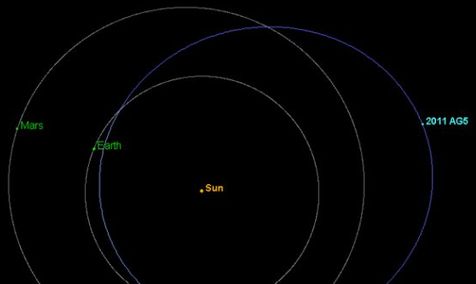
Talk about the asteroid was on the agenda during the 49th session of the Scientific and Technical Subcommittee of the United Nations Committee on the Peaceful Uses of Outer Space (COPUOS), held earlier in Vienna.
Due to its current location in the daytime sky, observations of 2011 AG5 cannot be made by Earth-based telescopes, so its orbit has not yet been determined to a level where scientists can confidently project its location decades into the future. But that day is coming.
"In September 2013, we have the opportunity to make additional observations of 2011 AG5 when it comes within 91 million miles (147 million kilometers) of Earth," said Don Yeomans, manager of NASA's Near-Earth Object Program Office at the Jet Propulsion Laboratory in Pasadena, California.
"It will be an opportunity to observe this space rock and further refine its orbit. Because of the extreme rarity of an impact by a near-Earth asteroid of this size, I fully expect we will be able to significantly reduce or rule out entirely any impact probability for the foreseeable future." Even better observations will be possible in late 2015.
To be a real danger to Earth and have a strike probability of 1 in 625, the asteroid has to fly through a particular keyhole-like area of space in September 2013. Schweickart said a decision to deflect 2011 AG 5 away from this keyhole, by changing its path using gravitational effects, should be made "very soon, if not now".
"If a keyhole deflection is ruled out as option, a direct deflection is marginally possible, at best," he said, adding that directly deflecting the asteroid would be difficult with existing launch vehicle capability.
2011 AG5 will next be near Earth in February of 2023 when it will pass the planet no closer than about 1 million miles (1.6 million kilometers). In 2028, the asteroid will again be in the area, coming no closer than about 10.4 million miles (16.7 million kilometers).
The Near-Earth Object Program Office states the Earth's gravitational influence on the space rock during these flybys has the potential to place the space rock on an impact course for Feb. 5, 2040.

© NASA/JPL/Caltech/NEOPO
The orbit of asteroid 2011 AG5 carries it beyond the orbit of Mars and as close to the sun as halfway between Earth and Venus.
The orbit of asteroid 2011 AG5 carries it beyond the orbit of Mars and as close to the sun as halfway between Earth and Venus.
Talk about the asteroid was on the agenda during the 49th session of the Scientific and Technical Subcommittee of the United Nations Committee on the Peaceful Uses of Outer Space (COPUOS), held earlier in Vienna.
Due to its current location in the daytime sky, observations of 2011 AG5 cannot be made by Earth-based telescopes, so its orbit has not yet been determined to a level where scientists can confidently project its location decades into the future. But that day is coming.
"In September 2013, we have the opportunity to make additional observations of 2011 AG5 when it comes within 91 million miles (147 million kilometers) of Earth," said Don Yeomans, manager of NASA's Near-Earth Object Program Office at the Jet Propulsion Laboratory in Pasadena, California.
"It will be an opportunity to observe this space rock and further refine its orbit. Because of the extreme rarity of an impact by a near-Earth asteroid of this size, I fully expect we will be able to significantly reduce or rule out entirely any impact probability for the foreseeable future." Even better observations will be possible in late 2015.
To be a real danger to Earth and have a strike probability of 1 in 625, the asteroid has to fly through a particular keyhole-like area of space in September 2013. Schweickart said a decision to deflect 2011 AG 5 away from this keyhole, by changing its path using gravitational effects, should be made "very soon, if not now".
"If a keyhole deflection is ruled out as option, a direct deflection is marginally possible, at best," he said, adding that directly deflecting the asteroid would be difficult with existing launch vehicle capability.
2011 AG5 will next be near Earth in February of 2023 when it will pass the planet no closer than about 1 million miles (1.6 million kilometers). In 2028, the asteroid will again be in the area, coming no closer than about 10.4 million miles (16.7 million kilometers).
The Near-Earth Object Program Office states the Earth's gravitational influence on the space rock during these flybys has the potential to place the space rock on an impact course for Feb. 5, 2040.
Police forces across the UK have received numerous calls after a large fireball, thought to be a meteor, was spotted in the sky.
Reports of a "bright light" and an "orange glow" were received by police across Scotland and the north of England around 9.40pm yesterday.
The Met Office tweeted: "Hi All, for anyone seeing something in the night sky, we believe it was a meteorite."
The Kielder Observatory also reported the sighting of a "huge fireball" travelling from north to south over Northumberland at 9.41pm.
The Observatory posted on Twitter: "Of 30 years observing the sky £fireball best thing I have ever seen period."
Meteors are particles from space that burn up in a streak of light as they enter the Earth's atmosphere, whereas meteorites are larger objects that survive the trip and reach the surface of the Earth.
Dr David Whitehouse, an author and astronomer, said: "Judging by its brightness, it may have have been large enough to survive and hit the ground but until people work out its trajectory we won't have any idea where it might have come down."
Dr Whitehouse said the object was about the size of a fist and was probably the debris of a planet that never properly formed.
"It's a chunk of rock that's probably come from somewhere between Mars and Jupiter has been in space for thousands of millions of years.
"There are 10s of thousands of bits of rock and grains of sand orbiting between Mars and Jupiter. Some of it comes out of that orbit and some of it hits the Earth."
A spokesman for Strathclyde Police said the force had been "inundated" with calls about a bright object in the sky across the west of Scotland.
A Durham Police spokeswoman said a number of calls came in around 9.45pm from concerned members of public who had seen a "bright light or a fire in the sky" and believed it may have been incidents involving an aircraft.
"It has been confirmed with air traffic control that there are no incidents of aircraft in difficult and nothing registered on radar," she said.
"The sightings are believed to be either an asteroid burning out or similar which has been restricted to the upper atmosphere only."
Grampian Police said reports of people seeing a "flare or a bright object with a tail" were received from across the region.
And Dumfries and Galloway Constabulary said numerous calls were made about a "large ball of fire in the sky" across Annandale and Eskdale. One user wrote on the force's Facebook page: "It was awesome to see! Really big and bright!"
A force spokesman wrote on Facebook: "A number of reports have been received from the public reporting observing bright lights or what is described as a large ball of fire in the sky.
"Inquiry has confirmed that this is actually a low level meteor shower."
Meanwhile, Lothian and Borders Police said it had received "quite a lot" of calls from members of the public.
Strathclyde Police and Central Scotland Police checked with air traffic control who confirmed there were no concerns and all aircraft was accounted for.
Coastguard also received calls from members of the public asking if a flare had been used. One call was made to the coastguard in Stornoway, with one person reporting seeing a flare in the sky.
Hundreds of people took to Twitter to report similar sightings across Scotland and the north of England.
People described seeing a bright fireball moving across the sky with a large tail.
Adrian West, of Meteorwatch, said he had seen reports of sightings from Scotland to Devon.
He said he spotted the meteor in Berkshire and believed it could have gone down in the English Channel or the Bay of Biscay.
Mr West told the BBC it was a "fireball flying from north to south", that was "very bright in the sky" and lasted for a few seconds.
He said: "It had a very bright orange nucleus and a green tail.
"It was seen by hundreds, maybe thousands of people."
Reports of a "bright light" and an "orange glow" were received by police across Scotland and the north of England around 9.40pm yesterday.
The Met Office tweeted: "Hi All, for anyone seeing something in the night sky, we believe it was a meteorite."
The Kielder Observatory also reported the sighting of a "huge fireball" travelling from north to south over Northumberland at 9.41pm.
The Observatory posted on Twitter: "Of 30 years observing the sky £fireball best thing I have ever seen period."
Meteors are particles from space that burn up in a streak of light as they enter the Earth's atmosphere, whereas meteorites are larger objects that survive the trip and reach the surface of the Earth.
Dr David Whitehouse, an author and astronomer, said: "Judging by its brightness, it may have have been large enough to survive and hit the ground but until people work out its trajectory we won't have any idea where it might have come down."
Dr Whitehouse said the object was about the size of a fist and was probably the debris of a planet that never properly formed.
"It's a chunk of rock that's probably come from somewhere between Mars and Jupiter has been in space for thousands of millions of years.
"There are 10s of thousands of bits of rock and grains of sand orbiting between Mars and Jupiter. Some of it comes out of that orbit and some of it hits the Earth."
A spokesman for Strathclyde Police said the force had been "inundated" with calls about a bright object in the sky across the west of Scotland.
A Durham Police spokeswoman said a number of calls came in around 9.45pm from concerned members of public who had seen a "bright light or a fire in the sky" and believed it may have been incidents involving an aircraft.
"It has been confirmed with air traffic control that there are no incidents of aircraft in difficult and nothing registered on radar," she said.
"The sightings are believed to be either an asteroid burning out or similar which has been restricted to the upper atmosphere only."
Grampian Police said reports of people seeing a "flare or a bright object with a tail" were received from across the region.
And Dumfries and Galloway Constabulary said numerous calls were made about a "large ball of fire in the sky" across Annandale and Eskdale. One user wrote on the force's Facebook page: "It was awesome to see! Really big and bright!"
A force spokesman wrote on Facebook: "A number of reports have been received from the public reporting observing bright lights or what is described as a large ball of fire in the sky.
"Inquiry has confirmed that this is actually a low level meteor shower."
Meanwhile, Lothian and Borders Police said it had received "quite a lot" of calls from members of the public.
Strathclyde Police and Central Scotland Police checked with air traffic control who confirmed there were no concerns and all aircraft was accounted for.
Coastguard also received calls from members of the public asking if a flare had been used. One call was made to the coastguard in Stornoway, with one person reporting seeing a flare in the sky.
Hundreds of people took to Twitter to report similar sightings across Scotland and the north of England.
People described seeing a bright fireball moving across the sky with a large tail.
Adrian West, of Meteorwatch, said he had seen reports of sightings from Scotland to Devon.
He said he spotted the meteor in Berkshire and believed it could have gone down in the English Channel or the Bay of Biscay.
Mr West told the BBC it was a "fireball flying from north to south", that was "very bright in the sky" and lasted for a few seconds.
He said: "It had a very bright orange nucleus and a green tail.
"It was seen by hundreds, maybe thousands of people."
Meteor Shower Dazzles Victorians Lucky Enough to See It
UPDATE: A fireball that streaked through the sky last night had many thinking a plane had crashed.
The meteor was seen across Victoria at about 10.45pm, including at Anglesea, Frankston, Berwick, Cairnlea, Tullamarine, Dandenong.
The fireball even caused a sensation in the UK with police inundated with emergency phone calls.
The control tower in Melbourne's Tullamarine Airport was also flooded with calls from locals fearing there had been a plane crash.
Astronomer David Reneke said it was unusual that the fireball was spotted across the globe and said it was probably the lead up to a meteor shower that was about to happen.
He said usually at the end February fireballs were often seen but not in March.
"To be seen around the world - it's crazy," he said.
"They are just slow moving bits of rock that catch on fire and burn.
"On occasions they even explode."
Herald Sun reader Brad Dorrington, of Newborough, witnessed the sky show.
"(It) looked amazing several red hot glows with a trail behind them with what looked to be dust behind it," he said.
Benjamin Cross, of Berwick, said it was surreal to glimpse the fiery tail.
"(It was) the most amazing thing I have ever seen," he said.
The meteor was seen across Victoria at about 10.45pm, including at Anglesea, Frankston, Berwick, Cairnlea, Tullamarine, Dandenong.
The fireball even caused a sensation in the UK with police inundated with emergency phone calls.
The control tower in Melbourne's Tullamarine Airport was also flooded with calls from locals fearing there had been a plane crash.
Astronomer David Reneke said it was unusual that the fireball was spotted across the globe and said it was probably the lead up to a meteor shower that was about to happen.
He said usually at the end February fireballs were often seen but not in March.
"To be seen around the world - it's crazy," he said.
"They are just slow moving bits of rock that catch on fire and burn.
"On occasions they even explode."
Herald Sun reader Brad Dorrington, of Newborough, witnessed the sky show.
"(It) looked amazing several red hot glows with a trail behind them with what looked to be dust behind it," he said.
Benjamin Cross, of Berwick, said it was surreal to glimpse the fiery tail.
"(It was) the most amazing thing I have ever seen," he said.
Comment: It's very unlikely that the one in Australia was the same as the one in the UK. Meteors only light up like that when entering the final stages of their descent. If it were seen from Melbourne to Scotland, half the planet would surely have sat up and taken notice!
Despite feverish speculation from doomsayers, the near-Earth asteroid 2012 DA14 won't slam into our planet next year, NASA researchers say.
The asteroid, which astronomers estimate to be about 150 feet (45 meters) across, will give Earth an uncomfortably close shave on Feb. 15, 2013, coming nearer to our planet than the satellites we've lofted to geostationary orbit. But 2012 DA14 poses no real impact danger on that pass, according to NASA scientists.

"Its orbit about the sun can bring it no closer to the Earth's surface than 3.2 Earth radii on February 15, 2013," researchers with the Near-Earth Object Program Office, at NASA's Jet Propulsion Laboratory in Pasadena, Calif., wrote in an update on March 6.
One Earth radius is roughly 3,963 miles (6,378 kilometers) at the equator. So by this reckoning, the nearest 2012 DA14 can get to us next year is 12,680 miles (20,406 km).
For comparison, satellites in geosynchronous orbit circle our planet at an altitude of 22,245 miles (35,800 km). Other satellites orbit much lower. The International Space Station, for example, flies at around 240 miles (386 km) above the planet.
2012 DA14 was discovered late last month by astronomers at the La Sagra Observatory in southern Spain. Its path around the sun is roughly similar to that of Earth, and it makes relatively close approaches to our planet twice per orbit.
Calculations show that the space rock came within about 1.5 million miles (2.5 million km) this past Feb. 16, or about six times the distance from Earth to the moon.
Next February's much closer encounter has ignited something of a media firestorm, with various outlets publishing stories with headlines such as "Incoming! Asteroid 2012 DA14" and "Tunguska-Sized Asteroid Homing on Earth."
This latter article is referring to the 1908 "Tunguska event," in which a comet or meteoroid exploded above the Podkamennaya Tunguska River in Siberia, flattening about 500,000 acres (2,000 square km) of forest.
While 2012 DA14 won't slam into us next February, humanity needs to remain vigilant against the asteroid threat, many researchers say. Huge impacts are a part of our planet's history, after all; one wiped out the dinosaurs 65 million years ago, and it's just a matter of time before another big space rock lines Earth up in its sights, astronomers say.
The asteroid, which astronomers estimate to be about 150 feet (45 meters) across, will give Earth an uncomfortably close shave on Feb. 15, 2013, coming nearer to our planet than the satellites we've lofted to geostationary orbit. But 2012 DA14 poses no real impact danger on that pass, according to NASA scientists.

© NASA/JPL Near-Earth Object Program Office
In this oblique view, the path of near-Earth asteroid 2012 DA14 is seen passing close to Earth on Feb. 15, 2013.
In this oblique view, the path of near-Earth asteroid 2012 DA14 is seen passing close to Earth on Feb. 15, 2013.
One Earth radius is roughly 3,963 miles (6,378 kilometers) at the equator. So by this reckoning, the nearest 2012 DA14 can get to us next year is 12,680 miles (20,406 km).
For comparison, satellites in geosynchronous orbit circle our planet at an altitude of 22,245 miles (35,800 km). Other satellites orbit much lower. The International Space Station, for example, flies at around 240 miles (386 km) above the planet.
2012 DA14 was discovered late last month by astronomers at the La Sagra Observatory in southern Spain. Its path around the sun is roughly similar to that of Earth, and it makes relatively close approaches to our planet twice per orbit.
Calculations show that the space rock came within about 1.5 million miles (2.5 million km) this past Feb. 16, or about six times the distance from Earth to the moon.
Next February's much closer encounter has ignited something of a media firestorm, with various outlets publishing stories with headlines such as "Incoming! Asteroid 2012 DA14" and "Tunguska-Sized Asteroid Homing on Earth."
This latter article is referring to the 1908 "Tunguska event," in which a comet or meteoroid exploded above the Podkamennaya Tunguska River in Siberia, flattening about 500,000 acres (2,000 square km) of forest.
While 2012 DA14 won't slam into us next February, humanity needs to remain vigilant against the asteroid threat, many researchers say. Huge impacts are a part of our planet's history, after all; one wiped out the dinosaurs 65 million years ago, and it's just a matter of time before another big space rock lines Earth up in its sights, astronomers say.
| Discovery Date: | March 2, 2012 |
| Magnitude: | 19.6 mag |
| Discoverer: | R. E. Hill (Mount Lemmon) |
The orbital elements are published on M.P.E.C. 2012-E39.
| Discovery Date: | January 13, 2012 |
| Magnitude: | 6 mag |
| Discoverer: | Alan Watson (STEREO-B spacecraft) |
The orbital elements are published on M.P.E.C. 2012-E18.
A fiery meteor has lit up the sky over Victoria and Tasmania.
The object, described as a glowing red fireball moving horizontally across the sky about 10.45pm (AEDT) on Sunday, was an unusual sight for this time of year, according to astronomer David Reneke.
Observers say the meteor was visible for about 20 seconds.
Professor Reneke says he and his colleagues are at a loss to explain the timing and exact nature of the meteor.
It may have been a slow-moving piece of rock that ignited or a piece of space junk, he said.
"It's unprecedented, we don't seem to be in a meteor shower period at the moment," Professor Reneke said.
"(Fireballs) tend to be very slow moving and they travel more horizontally than vertically... if you ever see one, they stick in your mind for the rest of your life."
Professor Reneke says he has received dozens of reported sightings from across Victoria and Tasmania.
Social network site Twitter was abuzz on Monday with reports of the meteor.
The phenomenon comes after a fireball was reported in skies over the United Kingdom on Saturday, with police inundated with calls from concerned residents, The Guardian reports.
It is impossible to be sure if the sighted meteors in the UK and Australia are the same, Professor Reneke says.
The object, described as a glowing red fireball moving horizontally across the sky about 10.45pm (AEDT) on Sunday, was an unusual sight for this time of year, according to astronomer David Reneke.
Observers say the meteor was visible for about 20 seconds.
Professor Reneke says he and his colleagues are at a loss to explain the timing and exact nature of the meteor.
It may have been a slow-moving piece of rock that ignited or a piece of space junk, he said.
"It's unprecedented, we don't seem to be in a meteor shower period at the moment," Professor Reneke said.
"(Fireballs) tend to be very slow moving and they travel more horizontally than vertically... if you ever see one, they stick in your mind for the rest of your life."
Professor Reneke says he has received dozens of reported sightings from across Victoria and Tasmania.
Social network site Twitter was abuzz on Monday with reports of the meteor.
The phenomenon comes after a fireball was reported in skies over the United Kingdom on Saturday, with police inundated with calls from concerned residents, The Guardian reports.
It is impossible to be sure if the sighted meteors in the UK and Australia are the same, Professor Reneke says.
Unexplained "Phoenix Lights" explosion caught live on news broadcast
Phoenix's FOX 10 reporter Andrea Robinson was in the middle of an on-air report when an unexplained, bright white explosion appeared in the distance behind her.
The strange blast was caught on tape and aired live during Robinson's report. At first, news station employees thought the explosion was a transformer. But when FOX 10 checked with local utility providers APS and Salt River Project, they were told no transformers had blown in the area.
While the source of the explosion remains a mystery, it comes just before the 15th anniversary of one of the most-famous UFO sightings in recent history. On March 13, 1997, a cluster of glowing orbs moving in a V-shaped formation was spotted in the skies above Phoenix. That incident was also caught on film. The origin of the light formation has since been endlessly analyzed and debated.
Arizona is also home to Travis Walton, who famously claimed to have been abducted by a UFO in 1975. Walton has written a number of books on the subject, and his story was turned into the 1993 film "Fire in the Sky."
And while Phoenix officials remain stumped by the strange light explosion, FOX 10 has reached out to the public asking for assistance in explaining exactly what was caught on film.
Cartersville - Scientists at the Tellus Science Museum said they observed a fireball in the sky over north Georgia Wednesday evening.
The NASA Meteoroid Environment Office confirmed that a bright fireball streaked across the skies over parts of Alabama, Tennessee and Georgia at 10:19 p.m. Wednesday. The fireball was captured by cameras at NASA's Marshall Space Flight Center in Huntsville, as well as by cameras in Tullahoma, Tenn., and at the Tellus Science Museum.
NASA says the meteor was first recorded at an altitude of 51.5 miles, just southeast of Tunnel Hill, Ga., moving to the west-southwest at about 33,500 mph. The fireball was last spotted near Rock Spring, Ga., along Ga. Highway 95.
(Idaho, USA) Blaine County sheriff's deputies responded to reports of loud booming noises in western Hailey last week, but could not find the source of the sounds.
Speculations about the source of the sounds, which were heard across the city and to the west, range from supersonic aircraft to explosive targets.
Sheriff's Lt. Jay Davis said that following reports of the sounds, deputies drove on Friday, March 2, into Croy Canyon and heard them also, but could not find their source.
"We have some suspicions," Davis said, including explosive targets, but he said the investigation is ongoing.
Tannerite is the trademark name for an ammonium nitrate/aluminum powder-based binary explosive used in target practice.
A gunshop owner in the Wood River Valley who asked to remain anonymous said that Tannarite, if used in sufficient quantities, could produce loud enough explosions to be heard far away. He said a high-caliber rifle had to be shot into the material to detonate it.
Dan Freeman, who farmed in Croy Canyon a few years ago, said he heard "ground-shaking" explosions from far to the west-southwest many times. He said his wife heard the explosions Friday from their home on Buttercup Road west of Hailey.
"In Croy Canyon, we sometimes would hear five to 10 explosions in a day, some bigger and some smaller," Freeman said. "I think we were hearing explosions from the bombing range east of Mountain Home Air Force Base."
Air Force Base Master Sgt. Andrew Leonard said he reviewed flight logs for supersonic aircraft at Mountain Home for last Friday and determined that multiple F-15E jets had flown in "military trains" about 50 miles west of Hailey at the time of the reports. However, Leonard said the jets are not allowed to fly fast enough in that area to break the sound barrier, which sets off sonic booms that can be heard many miles away.
Leonard said a bombing range west of Mountain Home could not be the source of loud noises more than 50 miles away in Hailey.
"We can barely hear them from here," he said.
Tony Evans: tevans@mtexpress.com
Speculations about the source of the sounds, which were heard across the city and to the west, range from supersonic aircraft to explosive targets.
Sheriff's Lt. Jay Davis said that following reports of the sounds, deputies drove on Friday, March 2, into Croy Canyon and heard them also, but could not find their source.
"We have some suspicions," Davis said, including explosive targets, but he said the investigation is ongoing.
Tannerite is the trademark name for an ammonium nitrate/aluminum powder-based binary explosive used in target practice.
A gunshop owner in the Wood River Valley who asked to remain anonymous said that Tannarite, if used in sufficient quantities, could produce loud enough explosions to be heard far away. He said a high-caliber rifle had to be shot into the material to detonate it.
Dan Freeman, who farmed in Croy Canyon a few years ago, said he heard "ground-shaking" explosions from far to the west-southwest many times. He said his wife heard the explosions Friday from their home on Buttercup Road west of Hailey.
"In Croy Canyon, we sometimes would hear five to 10 explosions in a day, some bigger and some smaller," Freeman said. "I think we were hearing explosions from the bombing range east of Mountain Home Air Force Base."
Air Force Base Master Sgt. Andrew Leonard said he reviewed flight logs for supersonic aircraft at Mountain Home for last Friday and determined that multiple F-15E jets had flown in "military trains" about 50 miles west of Hailey at the time of the reports. However, Leonard said the jets are not allowed to fly fast enough in that area to break the sound barrier, which sets off sonic booms that can be heard many miles away.
Leonard said a bombing range west of Mountain Home could not be the source of loud noises more than 50 miles away in Hailey.
"We can barely hear them from here," he said.
Tony Evans: tevans@mtexpress.com
A family in Oslo got a surprise when they visited their allotment garden cabin for the first time this season and found that a 585-gram (20 oz.) meteorite had ripped a hole through the roof. The space rock was discovered "lying five or six metres away," the cabin's owner, Rune Thomassen, told the local newspaper VG.
Such an event is rare in Norway; since 1848 the country has noted only 14 meteorite discoveries.
Astrophysicist Knut Jørgen Røed Ødegaard from the University of Oslo investigated the report and found it to be genuine.
"You can tell immediately that it's genuine from the burned crust, and you can also recognize it from how rough and unusual it is. It gives me goosebumps," Ødegaard told VG.
NASA Astrobiology Institute's Hans Amundsen noted the meteorite's unusual composition: "This is a very rare meteorite because you can see from the cut of it that it contains fragments from many different kinds of rock that have cemented together, forming a so-called breccia."
Such meteorites are caused by previous collisions, cementing together different types of material from impacts with asteroids or planets.This means the meteorite that landed on the Thomassens' cabin may very well have been blown off the surface of Mars at some point in the distant past!
"This is unique. This is double-unique," Ødegaard noted to VG.
According to Amundsen, such a meteorite is very valuable to researchers as well as private collectors, who may be willing to pay highly for it. Chunks of Mars have fetched USD $877 per gram in the past... making the Thomassens' find potentially worth over $500,000!
Norway's geological museum has the country's only meteorite collection "and they're the right ones to determine what kind of meteorite this is," Amundsen said.
Read more on this story here, and see coverage with photos and video on the VG site here (in Norwegian).

© Agence France-Presse
An apparent meteorite that split in two after hitting the roof of a cottage in central Oslo
The rock weighing 585 grammes (one pound, four ounces), which split in two, probably detached from a meteorite observed over Norway on March 1, experts said, and had landed on the empty hut in the Thomassen family's allotment in a working-class neighbourhood of the Norwegian capital.
Astrophysicist Knut Joergen Roed Oedegaard and his wife Anne Mette Sannes, a meteorite enthusiast, identified the object as a breccia, or a rock composed of broken fragments of minerals or rock.
"It is a sensation in more than one way. On one hand because it is rare that a piece of meteorite goes through a roof and on the other hand because it is a breccia, which is even harder to find," Sannes told AFP.
She said the owners of the meteorite pieces wanted to keep them in Norway, maybe in a museum.
Meteorites speed through space and generally break up as they enter our atmosphere, but it is extremely rare for the debris to fall on inhabited areas, according to Serge Koutchmy, a researcher at the Paris Astrophysical Institute.
"This family is very lucky," Koutchmy told AFP.
"First off because the piece of meteorite did not cause much damage, but also because it is worth a small fortune," he said.
A meteorite from Mars, for instance, can fetch around 5,000 kroner (670 euros, $876) per gramme, according to geophysicist Hans Amundsen quoted on the website of the Verdens Gang daily, adding though that it remained unclear where the meteorite pieces that landed in Oslo came from and how rare they were.
"I laid awake several hours last night and thought about how lucky I was," Liv Kibsgaard told Norwegian Broadcasting (NRK) on Wednesday. Her brother, who is a geologist, advised her to be careful with the meteorite, wrap it up "and don't tell anyone right away."
Kibsgaard's discovery of a 700-gram meteorite lying on the grass at Ekeberg followed the discovery of a 585-gram meteorite on Sunday that had crashed through the roof of a cabin in Oslo's Rodeløkka district. Astrophysicist Knut Jørgen Røed Ødegaard had predicted on Monday that more meteorites could likely be found as well, and he's been proven correct.
"There are still probably more pieces lying around waiting to be found, because we can see on these stones that pieces have fallen off as they traveled through the atmosphere," Ødegaard said. "It's just to keep your eyes open. Now there are stones from outer space in Oslo and Akershus."
Translated by Sott.net reader
Before the dust from the previous meteor had settled down, a new meteor illuminated the night sky over the eastern part of Norway. Tonight's fireball was observed at 00.09.30 on the 14th of March, and was visible for just under 6 seconds, Steinar Midtskogen told Dagbladet.
The astronomy enthusiast had erected a camera that surveys the sky from Voksenlia in Holmenkollåsen. It is so far not possible to determine whether the object burnt up in the atmosphere or if parts of it reached the ground in the form of meteorites.
This one was weaker than the one we saw on March 1st. Whether it produced any meteorite downfall is too early to tell but it is definitely a candidate that should be followed up, according to Midtskogen.
The third fireball
More data and searching of footage is needed before it is possible to say anything about its trajectory. Seen from Oslo the meteor was visible in the southwest, possibly over southern parts of Buskerud or Telemark.
This is the third large meteor over eastern Norway that has been caught on tape in the last few weeks. In addition to the meteor in the beginning of March, people driving to work in the morning rush-hour saw a similar sight on the 3d of February. Earlier this week it also became known that a meteorite probably went through a roof in Rodeløkka in Oslo.
The earth is constantly bombarded with matter from space. What is commonly known as stardust is tiny particles the size of sand grains that enter the atmosphere and is a common sight on a clear night. The earth is hit with these particles several million times each day.
More than usual
The larger fireballs that are observed several times a year are typically caused by objects from 15-20 grams up to 100 grams, says professor Kaare Aksnes at the Institute of Theoretical Astrophysics at the University in Oslo.
Comment: Okay, except the one which broke up and crashed to the ground a few nights ago contained several chunks, one of which weighed at least 700 grams!
Even though they are rarer than the tiny particles they still enter the atmosphere regularly over Norwegian territory. They often remain undetected because their trajectory takes them over uninhibited areas, in the daytime or when it is cloudy.
You can get meteors during daylight as well, but they would have to be large, Aksnes says.
On account of information indicating that this night's meteor was smaller than the fireball from the 1st of March, Aksnes holds it unlikely that fragments have survived the journey through the atmosphere without being burned up.
This one must have been significantly smaller. The particles do not have to be very big but can still illuminate a large part of the sky, Aksnes says.
Steinar Midtskogen, who started his camera project 8-9 years ago, believes he "has observed more luminous meteors than usual lately."
This can be a coincidence, or it can be because the earth enters areas in space that holds larger amounts of debris that then hits the atmosphere. Aksnes thinks the cause is the former.
The earth isn't presently in a portion of space that should cause a meteor swarm, Aksnes says.
The astronomy enthusiast had erected a camera that surveys the sky from Voksenlia in Holmenkollåsen. It is so far not possible to determine whether the object burnt up in the atmosphere or if parts of it reached the ground in the form of meteorites.
This one was weaker than the one we saw on March 1st. Whether it produced any meteorite downfall is too early to tell but it is definitely a candidate that should be followed up, according to Midtskogen.
The third fireball
More data and searching of footage is needed before it is possible to say anything about its trajectory. Seen from Oslo the meteor was visible in the southwest, possibly over southern parts of Buskerud or Telemark.
This is the third large meteor over eastern Norway that has been caught on tape in the last few weeks. In addition to the meteor in the beginning of March, people driving to work in the morning rush-hour saw a similar sight on the 3d of February. Earlier this week it also became known that a meteorite probably went through a roof in Rodeløkka in Oslo.
The earth is constantly bombarded with matter from space. What is commonly known as stardust is tiny particles the size of sand grains that enter the atmosphere and is a common sight on a clear night. The earth is hit with these particles several million times each day.
More than usual
The larger fireballs that are observed several times a year are typically caused by objects from 15-20 grams up to 100 grams, says professor Kaare Aksnes at the Institute of Theoretical Astrophysics at the University in Oslo.
Comment: Okay, except the one which broke up and crashed to the ground a few nights ago contained several chunks, one of which weighed at least 700 grams!
Even though they are rarer than the tiny particles they still enter the atmosphere regularly over Norwegian territory. They often remain undetected because their trajectory takes them over uninhibited areas, in the daytime or when it is cloudy.
You can get meteors during daylight as well, but they would have to be large, Aksnes says.
On account of information indicating that this night's meteor was smaller than the fireball from the 1st of March, Aksnes holds it unlikely that fragments have survived the journey through the atmosphere without being burned up.
This one must have been significantly smaller. The particles do not have to be very big but can still illuminate a large part of the sky, Aksnes says.
Steinar Midtskogen, who started his camera project 8-9 years ago, believes he "has observed more luminous meteors than usual lately."
This can be a coincidence, or it can be because the earth enters areas in space that holds larger amounts of debris that then hits the atmosphere. Aksnes thinks the cause is the former.
The earth isn't presently in a portion of space that should cause a meteor swarm, Aksnes says.
Comment: So, maybe larger amounts of debris are entering this 'area of space', rather than the other way around?
There has indeed been an incredible number of fireballs lately, of which the three over eastern Norway are just a few...
9 March, Fireball Spotted Over North Georgia
4 March: Meteor Shower Dazzles Victorians Lucky Enough to See It
4 March: Thousands Witness Spectacular Fireball Streak Over UK
2 March: Fireball seen from southern Norway and Sweden
2 March: Green Fireball Seen All Over Southeastern Canada
1 March: Green Object Reported in the Sky Over Newfoundland
29 February: What Was The Bright Flash In The Sky Tuesday Night?
22 February: "Huge fireball" streaks through Edmonton sky
22 February: Meteor Rain in China
14 February: Exploding UFO Wakes Thousands in South Carolina
12 February: Exploding Fireball recorded over Okayama, Japan
5 February: Fireball with huge tail seen over Western Australia
5 February: Fireball Photographed Over Corfu, Greece
4 February: East coast of US lights up as another enormous fireball streaks through sky
2 February: Huge Fireball Over Tokyo, 2 February 2012
1 February: Wednesday night's Texas meteor so bright it was seen in Kansas
1 February: Halifax 'fireball' probably a meteor
Mystery "Boom" Heard & Felt Across Georgia Region
WSAV is looking into reports of a "boom" felt across the region this morning.
We checked with the Chatham Emergency Managemet Agency and the US Geological Survey. Neither report any tremors in the area.
The National Weather Service says there was no weather related activity in the area.
As far as military bases, Hunter, Ft. Stewart and Beaufort Marine Corp Air Station all say it didn't have anything to do with them.
However, the Air National Guard says anytime military jets are training off the coast they can cause a sonic boom.
And GEMA confirms that they've talked to the military and they do have some reports of training exercises going on.
Here's what some of you had to say on Facebook:
"Malinda Naquin I'm in Richmond Hill and it sounded like it does when a hard storm is starting up, the roof kind of 'popped' and then the windows rattled. But, it was sunny so I figured it was a sonic boom. We hear Ft. Stewart all the time now, again, but usually that is lower in tone than this was."
"Teresa Gocial too many people from all around felt it, scared the crap outta me shook my house like something slammed into it..nothing like what I normally feel from Ft. Stewart"
"Dee Southworth Hear it and felt it on St. Simons. I thought one of our large live oaks fell near the house.
We did more digging and found something called the Seneca Guns.
Here's what the USGS says about the phenomenom:
We checked with the Chatham Emergency Managemet Agency and the US Geological Survey. Neither report any tremors in the area.
The National Weather Service says there was no weather related activity in the area.
As far as military bases, Hunter, Ft. Stewart and Beaufort Marine Corp Air Station all say it didn't have anything to do with them.
However, the Air National Guard says anytime military jets are training off the coast they can cause a sonic boom.
And GEMA confirms that they've talked to the military and they do have some reports of training exercises going on.
Here's what some of you had to say on Facebook:
"Malinda Naquin I'm in Richmond Hill and it sounded like it does when a hard storm is starting up, the roof kind of 'popped' and then the windows rattled. But, it was sunny so I figured it was a sonic boom. We hear Ft. Stewart all the time now, again, but usually that is lower in tone than this was."
"Teresa Gocial too many people from all around felt it, scared the crap outta me shook my house like something slammed into it..nothing like what I normally feel from Ft. Stewart"
"Dee Southworth Hear it and felt it on St. Simons. I thought one of our large live oaks fell near the house.
We did more digging and found something called the Seneca Guns.
Here's what the USGS says about the phenomenom:
"Earthquake "booms" have been reported for a long time, and they tend to occur more in the Northeastern US and along the East Coast. Of course, most "booms" that people hear or experience are actually some type of cultural noise, such as some type of explosion, a large vehicle going by, or sometimes a sonic boom, but there have been many reports of "booms" that cannot be explained by man-made sources. No one knows for sure, but scientists speculate that these "booms" are probably small shallow earthquakes that are too small to be recorded, but large enough to be felt by people nearby.
As it turns out....there are many factors that contribute to the "sound' that an earthquake makes. To begin to understand these factors we have to understand the different types of waves, the speed they travel through the earth, and the speed that sound travels through the air."
Recent meteor may have left pieces in Walker County

© Christi McEntyre
This satellite photo provided by NASA shows the projected trajectory and possible impact zone of the meteorite. Lucky residents or property owners in this or surrounding areas might just find a small visitor from space some-where on their land. Click on image to enlarge.
Bill Cooke, Walker County native and current lead member of the NASA Meteorite Environmental Office, confirmed that NASA meteor-tracking cameras in Huntsville, Ala., Tullahoma, Tenn., and at the Tellus Science Museum in Cartersville, Ga., detected the bright fireball of a meteor entering Earth's atmosphere approximately 52 miles northeast of Rocky Face in Whitfield County at 10:19 p.m. on March 7.
The meteor was estimated to weigh about 50 pounds before its descent to Earth, at which time the intense heat of atmospheric entry would have broken the space rock into multiple smaller pieces.
NASA lost track of the meteor's fireball - meaning its disintegration was nearly complete - about 17 miles above Ga. 95 southeast of Rock Spring.
Cooke and his team at NASA estimate that small remnants of the meteor - weighing in at one pound or less - may have survived reentry and landed somewhere between the Walker County Correctional Facility to the east and Cove Road to the west.
"Anyone in this area who has noticed an unusual rock found after the night of March 7th should note the location of the find and are encouraged to contact the NASA Meteoroid Environment Office at the Marshall Space Flight Center," said Cooke. "Potential meteorite hunters are reminded that meteorites belong to the owner of the property on which they land, and that one should obtain the permission of the property owners before conducting a search."
Cooke hopes members of the public living in the Rock Spring or Cove Road areas will have memories of strange sounds or sights occurring the night of March 7 and will be able to point NASA in a more precise direction to de-termine where the meteorites may have landed.
"Often with meteorites, it's the public that gives us clues as to where to look," he said.
Jim Smith, longtime Walker County school board member and former teacher of Bill Cooke, was unable to see the meteor through his planetarium and observatory in Chickamauga, but later recalled hearing the event.
Near-miss asteroid to return even closer next year
An amateur team spotted the unusual asteroid, named 2012 DA14, on February 22.
Its small size and orbit meant that it was observed only after it had flown past Earth at about seven times the distance of the Moon.
However, current predictions indicate that on its next flyby, due on 15 February 2013, it will pass Earth at just 24 000 km - closer than many commercial satellites.
"This is a safe distance, but it is still close enough to make the asteroid visible in normal binoculars," said Detlef Koschny, responsible for near-earth objects in ESA's Space Situational Awareness (SSA) office.
The asteroid was discovered by the La Sagra Sky Survey observatory, in the southeast of Spain, near Granada, at an altitude of 1700 m, one of the darkest, least light-polluted locations on the European mainland.
"Considering its path in the morning sky, its rather fast angular motion, the quite faint and fading brightness and its orbit high above the plane of Earth's orbit, it was a slippery target - and easily could have escaped undetected during this Earth visit," said Jaime Nomen, one of the discoverers.
"A preliminary orbit calculation shows that 2012 DA14 has a very Earth-like orbit with a period of 366.24 days, just one more day than our terrestrial year, and it 'jumps' inside and outside of the path of Earth two times per year."
While an impact with Earth has been ruled out on the asteroid's next visit, astronomers will use that close approach for more studies and calculate the Earth and Moon's gravitational effects on it.
"We will also be keen to see the asteroid's resulting orbit after the next close approach in order to compute any future risk of impact," said Koschny.
The La Sagra Sky Survey is operated by the Observatorio Astronomico de Mallorca and has recently joined ESA's SSA programme. In the future it will provide observations to the asteroid data hub that ESA is developing.
Together with information on space weather and debris, its information will help European scientists and policy-makers understand and assess hazards, particularly if an Earth-threatening asteroid is ever found.
The discovery of 2012 DA14 is particularly significant for the Agency's SSA office, because it is typical of the estimated half a million undiscovered near-Earth objects up to 30 m across.
"The goal is to be able to spot them at least three weeks before closest approach to Earth."
"We are developing a system of automated optical telescopes that can detect asteroids just like this one, with the goal of being able spot them at least three weeks before closest approach to Earth," said Koschny.
To achieve this, ESA specialists supported by European industry are planning a network of 1 m-diameter telescopes with a combined field of view large enough to image the complete sky in one night.
Its small size and orbit meant that it was observed only after it had flown past Earth at about seven times the distance of the Moon.
However, current predictions indicate that on its next flyby, due on 15 February 2013, it will pass Earth at just 24 000 km - closer than many commercial satellites.
"This is a safe distance, but it is still close enough to make the asteroid visible in normal binoculars," said Detlef Koschny, responsible for near-earth objects in ESA's Space Situational Awareness (SSA) office.
The asteroid was discovered by the La Sagra Sky Survey observatory, in the southeast of Spain, near Granada, at an altitude of 1700 m, one of the darkest, least light-polluted locations on the European mainland.
"Considering its path in the morning sky, its rather fast angular motion, the quite faint and fading brightness and its orbit high above the plane of Earth's orbit, it was a slippery target - and easily could have escaped undetected during this Earth visit," said Jaime Nomen, one of the discoverers.
"A preliminary orbit calculation shows that 2012 DA14 has a very Earth-like orbit with a period of 366.24 days, just one more day than our terrestrial year, and it 'jumps' inside and outside of the path of Earth two times per year."
While an impact with Earth has been ruled out on the asteroid's next visit, astronomers will use that close approach for more studies and calculate the Earth and Moon's gravitational effects on it.
"We will also be keen to see the asteroid's resulting orbit after the next close approach in order to compute any future risk of impact," said Koschny.
The La Sagra Sky Survey is operated by the Observatorio Astronomico de Mallorca and has recently joined ESA's SSA programme. In the future it will provide observations to the asteroid data hub that ESA is developing.
Together with information on space weather and debris, its information will help European scientists and policy-makers understand and assess hazards, particularly if an Earth-threatening asteroid is ever found.
The discovery of 2012 DA14 is particularly significant for the Agency's SSA office, because it is typical of the estimated half a million undiscovered near-Earth objects up to 30 m across.
"The goal is to be able to spot them at least three weeks before closest approach to Earth."
"We are developing a system of automated optical telescopes that can detect asteroids just like this one, with the goal of being able spot them at least three weeks before closest approach to Earth," said Koschny.
To achieve this, ESA specialists supported by European industry are planning a network of 1 m-diameter telescopes with a combined field of view large enough to image the complete sky in one night.
Magnitude: 18.7 mag
Discoverer: A. R. Gibbs (Catalina)
The orbital elements are published on M.P.E.C. 2012-F30.
"Space Junk" Misses ISS
A
piece of space debris missed the International Space Station (ISS) on
Saturday, forcing its crew members to take shelter in rescue craft, NASA
said.
The debris "safely passed in front of the ISS," the U.S. space agency wrote on its Twitter account.
The six crew members were given the all clear to return to their normal duties.
NASA said the junk was a leftover from a February 2009 collision involving Russia's defunct military communications satellite Comsos 2251 and the U.S. commercial Iridium spacecraft.
The Soyuz spacecraft are used to ferry crew to and from the ISS, "for either a normal end of mission, or as a "rescue" craft," NASA explained.
Before getting into the capsules, the crew - two Americans, three Russians and a Dutch astronaut - closed all the hatches om the ISS.
NASA said earlier the debris was predicted to pass 14.8 kilometers below the space station.
This is the third time an ISS crew were told to follow the same procedure following similar incidents in 2009 and 2011.
The debris "safely passed in front of the ISS," the U.S. space agency wrote on its Twitter account.
The six crew members were given the all clear to return to their normal duties.
NASA said the junk was a leftover from a February 2009 collision involving Russia's defunct military communications satellite Comsos 2251 and the U.S. commercial Iridium spacecraft.
The Soyuz spacecraft are used to ferry crew to and from the ISS, "for either a normal end of mission, or as a "rescue" craft," NASA explained.
Before getting into the capsules, the crew - two Americans, three Russians and a Dutch astronaut - closed all the hatches om the ISS.
NASA said earlier the debris was predicted to pass 14.8 kilometers below the space station.
This is the third time an ISS crew were told to follow the same procedure following similar incidents in 2009 and 2011.

© NASA
Sunlight glints off the International Space Station with the blue limb of Earth providing a dramatic backdrop in this photo taken by an astronaut on the shuttle Endeavour just before it docked after midnight on Feb. 10, 2010 during the STS-130 mission.
Sunlight glints off the International Space Station with the blue limb of Earth providing a dramatic backdrop in this photo taken by an astronaut on the shuttle Endeavour just before it docked after midnight on Feb. 10, 2010 during the STS-130 mission.
The piece of space junk was spotted too late to move the orbiting laboratory out of the way and flew as close as 6.8 miles (11 kilometers) when it zoomed by at about 2:38 a.m. EDT (0638 GMT), NASA officials said.
While the chances of collision were remote, the potential danger of a hit was enough for Mission Control to order the station crew - which includes three Russians, two Americans and a Dutch astronaut - to seek shelter in two docked Soyuz space capsules just in case a quick escape to Earth is required.
"I don't see anything, which is good news," one of the station astronauts said in Russian, which was translated in a NASA broadcast.
It was the third time in 12 years that station astronauts took shelter from a close space debris pass.
NASA and its partners typically order an avoidance maneuver when a piece of space junk is expected to pass close by the space station and there are several days of advance notice. But this latest space debris threat was initially spotted on Friday morning, too late to plan a major maneuver, NASA officials said.
"We're not too concerned about it, but it's too late to do a [debris avoidance maneuver]," station flight director Jerry Jason radioed station commander Daniel Burbank, of NASA, and his crew late Friday.
According to NASA updates, the space debris is a remnant of the Russian Cosmos 2251 communications satellite. In 2009, the defunct spacecraft crashed into the U.S. satellite Iridium 33 in a massive space collision that created a huge cloud of more debris. The crash created 2,000 pieces of orbital debris.
While the size of the space debris was difficult to pin down, it was "relatively small," NASA spokesman Rob Navias said during NASA TV commentary of the space trash flyby.
NASA astronaut Don Pettit, who is the other American aboard the space station, radioed Mission Control Friday to say he hoped to try and snap a photo of the space debris if it was possible. But the space debris whizzed by the space station unseen.
Space junk is a growing threat for astronauts on the space station, as well as other satellites orbiting Earth. According to recent estimates, there is about 6,000 tons of space debris in orbit today. NASA and the U.S. military's Space Surveillance Network regularly track about 20,000 pieces of the debris in order to help other active satellites avoid collisions with the orbital trash.
Comment: SOTT wonders what is UP with all the recent alleged man-made space objects either falling out of the sky, or forcing astronauts to take shelter in lifeboats? Is it possible that it is not really "space junk" and such explanations are being offered to cover up the fact that the planet is being subjected to cometary fragment bombardment?
2 Small Asteroids Give Earth a Close Shave
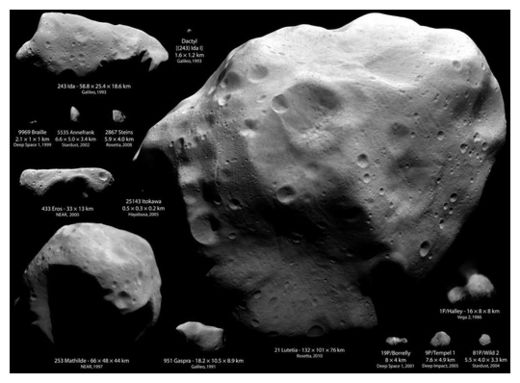
© Ted Stryk/Emily Lakdawalla
This montage of images from several different observations and missions shows asteroids and comets visited by spacecraft from Earth.
This montage of images from several different observations and missions shows asteroids and comets visited by spacecraft from Earth.
Two tiny asteroids zipped close by Earth today (March 26), passing between our planet and the orbit of the moon, but posed no threat of impacting our world, NASA scientists say.
The two space rocks flew by Earth in rapid fire; one zoomed by early in the day while the second buzzed the planet at 1:09 p.m. EDT (1709 GMT), according to astronomers with NASA's Asteroid Watch program.
"Both are very small (under 10 meters) and pose no risk," the scientists wrote in a Twitter update.
The first object, called asteroid 2012 FP35, came within 96,000 miles (154,000 km) of the Earth when it passed by earlier today, the scientists wrote. Asteroid 2012 FP35 is just under 30 feet (9 meters) wide, making it about the size of a tour bus.
The second asteroid is dubbed 2012 FS35 and crept even closer to Earth, coming within 36,000 miles (58,000 km) when it whipped by the planet. Asteroid 2012 FS35 is even smaller than its predecessor; at nearly 10 feet (3 meters) wide, it's only the size of a small car.
The paths of both asteroids brought them well inside the orbit of the moon, which typically circles Earth at a distance of about 238,000 miles (382,900 km). Asteroid 2012 FP35 - the farther of the two space rocks - passed within 0.4 lunar distances to Earth, while asteroid 2012 FS35 came within 0.17 lunar distances, NASA scientists said.
The two asteroids were first detected over the weekend and quickly dismissed as potential impact threats to Earth. Their small size means they would likely not survive the fiery trip through Earth's atmosphere to reach the surface.
NASA's Asteroid Watch project is part of the agency's Near-Earth Objects program based at the Jet Propulsion Laboratory in Pasadena, Calif. NASA scientists and other teams of astronomers regularly scan the sky for larger, potentially dangerous asteroids in order to determine if they pose a risk of impacting the Earth.
New Comet: P/2012 F5 (GIBBS)
CBET 3069 and M.P.E.C. 2012-F87,
issued on 2012, March 25, announced the discovery of a periodic comet
by A. R. Gibbs on Mar. 22.8, through the Mount Lemmon 1.5-m reflector.
On his images, Gibbs, found a stellar coma and a long, narrow tail about
7'.4 long in p.a. 292.5 deg. The new object has been designated P/2012
F5 (GIBBS) by the Minor Planet Center.
We tried its follow up at first on 2012, March 23.8, when this object was still listed in the NEO-CP webpage as "TF85899". We operated from the Malina River Observatory (Povoletto, Italy) through a 0.3-m, f/4.7 reflector + CCD, under a hazy sky. On our stackings we found a faint and narrow, streak, about 2-arcmin long, oriented toward PA 295 deg.
This feature was very close to the expected position of "TF85899" however, due to its faintness (R about 19.2) and curious shape, we suspected it might be a noise, rather than a real object, so we decided to go for a second night of follow-up, just to make sure. On 2012, Mar. 25.8, we repeated the observations of this object with the same set-up, and found again an odd aspect: kind of elongated and narrow tail, at least 30" long, toward PA300 (in these images we suspected that the tail might be longer than this, however our observations were hampered by a bright, nearby field star). The central condensation was very difficult to locate, hampering its precise astrometric measurement.
Meanwhile other observers reported about its curious shape in a the [Comets-ml] forum, so we had an independent confirmation that what we observed on Mar. 23.8 was actually a real (albeit odd) cometary object, and not an artifact.
Our confirmation image of March 23:
According to the preliminary orbital elements issued by the Minor Planet Center, P/2012 F5 has an orbital period of 5.32 years, an inclination on the ecliptic of 13.5 deg, semi-major axis of 3 AU and en eccentricity about 0.4. Its perihelion was reached in September 2010.
We tried its follow up at first on 2012, March 23.8, when this object was still listed in the NEO-CP webpage as "TF85899". We operated from the Malina River Observatory (Povoletto, Italy) through a 0.3-m, f/4.7 reflector + CCD, under a hazy sky. On our stackings we found a faint and narrow, streak, about 2-arcmin long, oriented toward PA 295 deg.
This feature was very close to the expected position of "TF85899" however, due to its faintness (R about 19.2) and curious shape, we suspected it might be a noise, rather than a real object, so we decided to go for a second night of follow-up, just to make sure. On 2012, Mar. 25.8, we repeated the observations of this object with the same set-up, and found again an odd aspect: kind of elongated and narrow tail, at least 30" long, toward PA300 (in these images we suspected that the tail might be longer than this, however our observations were hampered by a bright, nearby field star). The central condensation was very difficult to locate, hampering its precise astrometric measurement.
Meanwhile other observers reported about its curious shape in a the [Comets-ml] forum, so we had an independent confirmation that what we observed on Mar. 23.8 was actually a real (albeit odd) cometary object, and not an artifact.
Our confirmation image of March 23:
According to the preliminary orbital elements issued by the Minor Planet Center, P/2012 F5 has an orbital period of 5.32 years, an inclination on the ecliptic of 13.5 deg, semi-major axis of 3 AU and en eccentricity about 0.4. Its perihelion was reached in September 2010.
April Fools' Day Asteroid to Buzz Earth Sunday: No Joke!
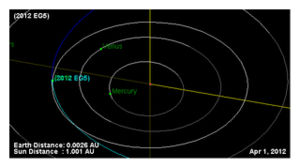
© NASA/JPL
This graphic depicts the orbit of asteroid 2012 EG5 (in blue) during its April Fool's Day flyby of Earth on April 1, 2012.
This graphic depicts the orbit of asteroid 2012 EG5 (in blue) during its April Fool's Day flyby of Earth on April 1, 2012.
An asteroid the size of a passenger jet will zoom close by Earth on Sunday (April 1) just in time for April Fools' Day, but it has no chance of hitting the Earth, NASA says.
The asteroid 2012 EG5 will be closer than the moon when it passes Earth at 5:32 a.m. EDT (0932 GMT). The space rock is about 150 feet wide (46 meters), according to a NASA update.
"Asteroid 2012 EG5 will safely pass Earth on April 1," scientists with NASA's Asteroid Watch program at the Jet Propulsion Laboratory in Pasadena, Calif., wrote in a Twitter statement.
The space rock may be visiting Earth on April Fools' Day, but its flyby is no prank. The asteroid will creep within 143,000 miles (230,000 kilometers) of Earth during its closest approach, which is just over half the distance between Earth and the moon's orbit. The moon typically circles the Earth at a distance of 238,000 miles (382,900 km).
Asteroid 2012 EG5 is the third relatively small asteroid to buzz the Earth in seven days. Two smaller asteroids passed near Earth on Monday (March 26).
Early Monday, the bus-size asteroid 2012 FP35 came within 96,000 miles (154,000 km) of Earth. It was followed a few hours later by asteroid 2012 FS35, which is the size of a car and passed Earth at a range of 36,000 miles (58,000 km).
Like asteroid 2012 EG5, those two smaller space rocks on Monday posed no risk of hitting Earth. Those space rocks were so small they would not survive the trip through Earth's atmosphere, even if they were aimed at our planet, Asteroid Watch researchers said.
Asteroid 2012 EG5 was discovered on March 13 by astronomers searching for near-Earth space rocks. Another space rock, the asteroid 2012 FA57, was discovered on March 28 and will fly by Earth on April 4 when it passes at a range just beyond the orbit of the moon.
Scientists with NASA's Near-Earth Object Program at JPL and other teams of astronomers regularly monitor the sky for larger, potentially dangerous asteroids to determine if they pose an impact threat to Earth.
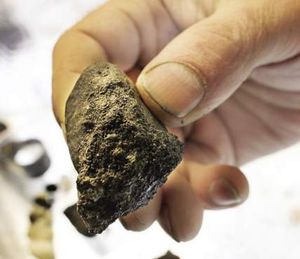

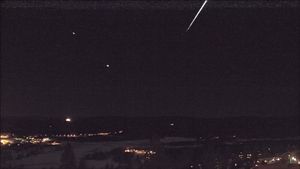
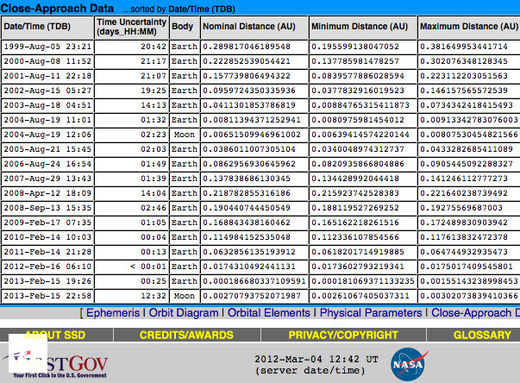
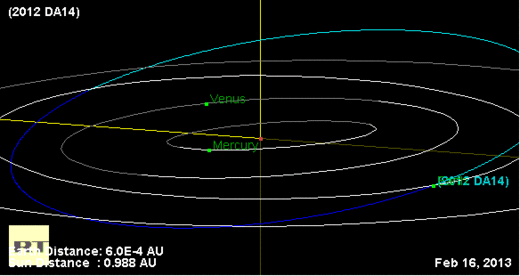
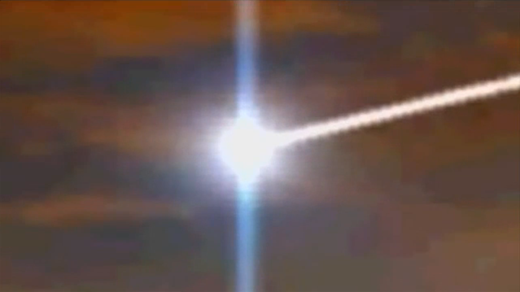
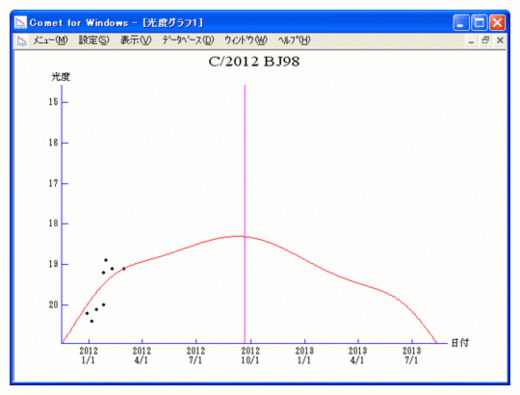

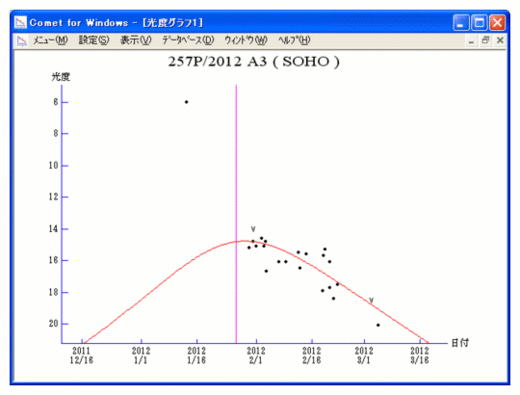
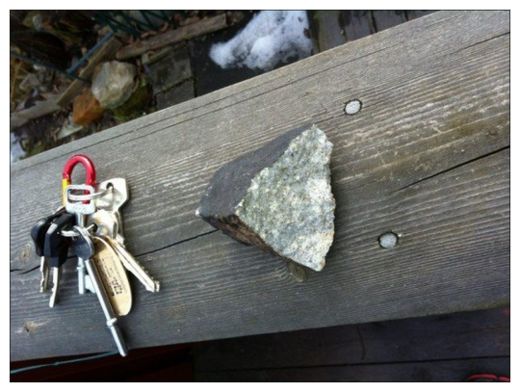





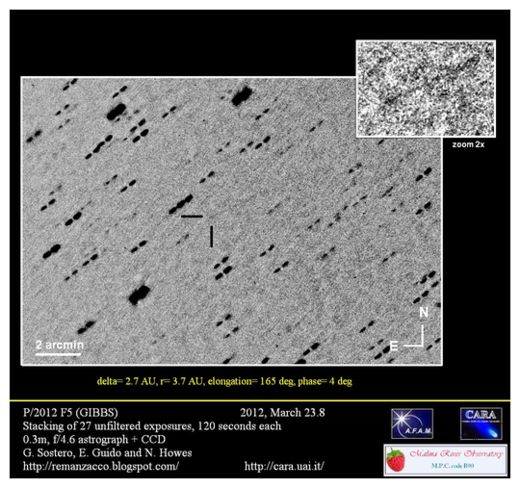
1 comment:
I am very happy to read this article. Thanks for giving us Amazing info. Fantastic post. Thanks For Sharing such an informative article
Adobe Photoshop Crack
Driver Booster Crack
3DMark Crack
IDM Crack
GoodSync Crack
Total Commander Crack
Post a Comment